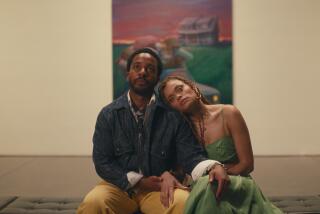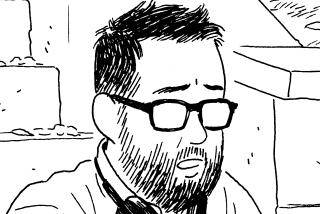The artists of ‘Red’ dig around in Mark Rothko’s mind
Works of art can do just about anything — except explain how other works of art work.
That’s one of the reasons many movies and books about artists fall short. They presume to tell us the truth about things they are in no position to explain, much less match the artistry of.
Documentary films do not face this problem. Three recent ones work wonders because they allow their subjects to speak for themselves. More important, Matthew Akers’ “Marina Abramovic: The Artist Is Present,” Corinna Belz’s”Gerhard Richter Painting”and Neil Berkeley’s “Beauty Is Embarrassing” do not reveal how Abramovic, Richter or Wayne White make their work.
Instead, they show us the consequences of what the artists have done by zeroing in on the responses their art elicits from viewers. This includes the artists themselves, who probably have spent more time looking at their own work than anyone else has.
“Red,” John Logan’s Tony Award-winning play that opens Sunday at the Mark Taper Forum, does something similar. Rather than attempting to explain why Mark Rothko’s paintings are meaningful — or trying to duplicate the magic that happened when they were painted — the sensible drama shows two people — Rothko (played by Alfred Molina) and his studio assistant Ken (played by Jonathan Groff) — arguing over a roomful of canvases, some finished, some works in progress.
The Russian-born painter, who died in 1970, was a notoriously slow worker , known to ponder his expansive abstractions for months, sometimes years, before allowing them to leave his studio. As strong-headed as every other member of the New York School — which put American art on the map after World War II — he brought a profound sense of moral purpose to painting.
“The challenge,” Logan says of doing a play about a great artist, “is pretension. The challenge is pompousness. The challenge is ‘because I am an artist I will treat my profession in an elevated way, as if it’s somehow floating above the clouds.’”
To counteract that, “Red” sticks to the basics. We do not watch Rothko slowly coax mesmerizing depths out of flat expanses of canvas. Epiphany-style flashes of painterly brilliance never take place. Nor are we invited into the painter’s psyche, whose torments are legendary. The same goes for his childhood, social circle and dream life — staples of the clichéd psychoanalyzing that plague so many stories about artists.
“It’s what we call a work play,” explains Logan. Everything that happens on stage — building stretchers, mixing paint, priming canvases and cleaning brushes — occurs in real time, as it does in artists’ studios. That’s also true of the looking, thinking and talking that are essential to art.
Molina describes “Red” as “a tussle between two very different people.”
“It’s Rothko’s bullying, his intellectual rigor, his refusal to compromise — the fact that he holds people to the same high standards that he holds himself — and Ken’s determination to keep up and learn something. That makes for a theatrical evening rather than just an interesting one. We could all go to a lecture about Rothko, but this isn’t that.”
Rothko’s abstractions are perfectly suited to a play about the time it takes to experience the richness of vision, both outward and inward. Slow, sensual and cerebral, they appear to be calm, cool and collected. But they’re more than that. Unlike Jackson Pollock’s paintings, which parade the spontaneity of their making across their surfaces, Rothko’s brooding rectangles of dissolving colors take viewers away from the brushwork with which they were made.
The artist’s touch is less important than a viewer’s eyes. The fact that Rothko was an artist is also less important than the fact that he existed. “There are certain obligations you have,” Molina says, “not to misrepresent him. But the fact that I’m playing an artist doesn’t really have any bearing on the work I do except that I have to know a little bit about what goes into the making of art. You have to know what you’re doing, but you’d be doing the same thing if your character were a truck driver.”
The play strips away sentimental myths about artistic integrity. Despite our tendency to separate style from substance, Logan does not gloss over Rothko’s showmanship: “You walk into that room [at the Tate Modern, where the Seagram Murals hang]. He is like the P.T. Barnum of the Abstract Expressionists. It is all theater. It is all drama. It is completely staged.”
“Red” also debunks myths about the creative process. “The mechanics of what we do,” Molina says, “is really rather dull. The notion that there is some kind of process, some kind of magical alchemical formula is nonsense.
“I don’t know my ‘process.’ But I can tell you what I do. The day-to-day grind of getting up and learning your lines and coming into work and going over the same bits is work. But the journey toward creativity is always mundane. Bloody hell. It’s the same for any creative endeavor. It’s not just about painting or the fine arts. It’s about everything we do. It’s a process of waiting.”
The cliché of the Romantic artist, toiling alone in his studio, plays no part in “Red,” which revolves around two men locked in a conversation about art’s place in life — and how they choose to live theirs.
“It’s a relationship play,” Logan says. “It’s as much a love story as anything else. Or a story about sex. There’s a scene in the middle of the play, sort of the fulcrum, where they prime a canvas. On the one hand, yes, they’re priming a canvas, but they’re also [having sex]. And if they’re not doing both, the scene doesn’t work, because it’s where two people come together in a very physical way. It’s like for the first 21/2 scenes they’re courting, and then they [have sex] and then they have to deal with the ramifications of that.”
In a sense, the relationship Logan sets up between the play and the paintings mirrors the relationship between criticism and art. Neither a substitute, in words, for actual canvases nor an attempt to replace experience with analysis, the play, like criticism, keeps its distance from its subject.
But the play is not a piece of criticism. About this Molina is unambiguous: “Do I want the audience to come out with a renewed interest in Rothko? My feeling is no. I don’t care. If they come out of a matinee and think, ‘We’ve got time, let’s just walk down the road to MOCA and look at the Rothkos there,’ well, great. But that’s not our mission.”
“Red” is not about Rothko’s paintings so much as it is about his tragic battle to make a place for them in a world he believed was on the cusp of being overrun by superficial self-involvement, inhuman pretense and unconscionable hypocrisy. It doesn’t take a great leap to imagine what he would say if he were alive today.
As a young man in St. Ives, England, Michael Grandage, the play’s director, grew up around artists. “I recognize Rothko as the norm,” he says. “Rothko’s not a freak. Or unique. He’s the way artists talk to each other. They’re passionate about what they do in the world that they live in. And that voice needed to be heard again, I thought. I think it’s quite an important way of communicating to a modern audience.
“That’s the bit I think I love most. The living man, the living artist who has a belief system. Engaging with it [today] might help a person understand life and their role in life and society. And that excited me. Actually. Enormously.”
More to Read
The biggest entertainment stories
Get our big stories about Hollywood, film, television, music, arts, culture and more right in your inbox as soon as they publish.
You may occasionally receive promotional content from the Los Angeles Times.










